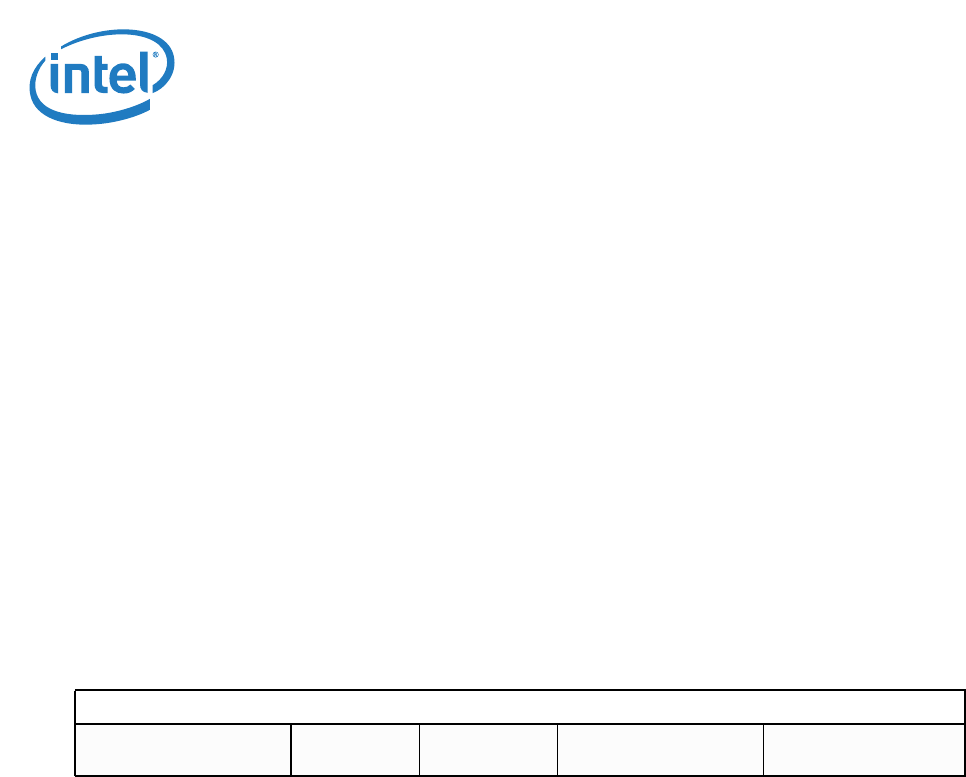
Intel
®
82575EB Gigabit Ethernet Controller — Legacy Receive Descriptor Format
Intel
®
82575EB Gigabit Ethernet Controller 324632-003
Software Developer’s Manual and EEPROM Guide Revision: 2.1
104 January 2011
If for any queue SRRCTL[n].BSIZEPACKET equals 0b, the buffer size defined by RCTL.BSIZE is used;
otherwise, the buffer size defined by SRRCTL[n].BSIZEPACKET is used.
In addition, for advanced descriptor usage the SRRCTL.BSIZEHEADER field is used to define the size of
the buffers allocated to headers.
The 82575 places no alignment restrictions on receive memory buffer addresses. This is desirable in
situations where the receive buffer was allocated by higher layers in the networking software stack, as
these higher layers might have no knowledge of a specific device's buffer alignment requirements.
Note: When the No Snoop Enable bit is used in advanced descriptors, the buffer address must be
16-bit aligned.
5.3.3 Legacy Receive Descriptor Format
A receive descriptor is a data structure that contains the receive data buffer address and fields for
hardware to store packet information. If SRRCTL[n].DESCTYPE = 000b, the 82575 uses the Legacy Rx
Descriptor as shown in Table 27. The shaded areas indicate fields that are modified by hardware upon
packet reception (descriptor write-back).
Table 27. Receive Descriptor (RDESC) Layout
Note: The checksum indicated here is the unadjusted “16-bit ones complement” of the packet. A
software assist might be required to back out appropriate information prior to sending it to
upper software layers. The packet checksum is always reported in the first descriptor (even
in the case of multi-descriptor packets).
5.3.3.1 Length Field
Upon receipt of a packet for the 82575, hardware stores the packet data into the indicated buffer and
writes the length, Packet Checksum, status, errors, and status fields. Length covers the data written to
a receive buffer including CRC bytes (if any). Software must read multiple descriptors to determine the
complete length for packets that span multiple receive buffers.
5.3.3.2 Packet Checksum
For standard 802.3 packets (non-VLAN) the Packet Checksum is by default computed over the entire
packet from the first byte of the DA through the last byte of the CRC, including the Ethernet and IP
headers. Software can modify the starting offset for the packet checksum calculation via the Receive
Checksum Control register (RXCSUM). To verify the TCP/UDP checksum using the Packet Checksum,
software must adjust the Packet Checksum value to back out the bytes that are not part of the true TCP
Checksum. When operating with the Legacy Rx Descriptor, the RXCSUM.IPPCSE and RXCSUM.PCSD
fields should be cleared (the default value).
63 48 47 40 39 32 31 16 15 0
0
Buffer Address [63:0]
8
VLAN Tag Errors Status 0 Packet Checksum
(See Note)
Length
